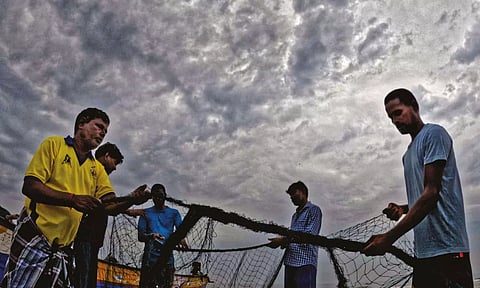

CHENNAI: The India Meteorological Department (IMD) had announced recently that the country had witnessed the hottest and driest month in August this year. However, the scenario in Chennai was slightly different.
Despite the sweltering heat and humidity that the city has been experiencing since April this year, it’s not an extreme heat condition. Though the southwest monsoon was not favourable to Kerala, namma Chennai had thunderstorm activity that recorded 67% excess rainfall.
With sudden downpours in the evenings for several days in the city and its suburbs, a ‘dry August’ is not applicable.
No extreme heat
Even last year, the southwest monsoon was favourable to Tamil Nadu. Though temperature crossed 40-degree Celsius in the summer this year, there were moderate to heavy spells in the city and suburbs, which gave denizens intermittent respite from the heat.
In June, weather stations in Meenambakkam recorded the second highest rainfall with 16 cm in the last 73 years. P Senthamarai Kannan, director, Area Cyclone Warning Centre, Chennai Meteorological Centre, stated that the IMD had announced the hottest month based on the overall maximum temperature in the country.
“But, the city and suburbs did not witness extreme heat conditions and had more rain compared to the overall State record. When there was rainfall in the district, it was either cyclonic circulation or convective rainfall.
Sudden downpour could be attributed to the system formed over the sea, as the circulation was supportive to coastal districts, including the city,” he said.
Sudden downpour
As the southwest monsoon has been weaker, it was hotter in the west coastal districts last month. It was different for north Tamil Nadu, especially in Chennai, which had recorded the highest rainfall in the State.
“We had more thunderstorm activity and excess rainfall in the city and suburbs. Overall, we had more wet spells compared to dry days in the last few months,” said Srikanth, an independent weather blogger.
Talking about the northeast monsoon 2023, experts predicted the monsoon season to be normal for Tamil Nadu unlike the previous years. In June this year, Madurai, Palayamkottai, and Thoothukudi districts saw extreme hot weather the entire month.
In Chennai and its outskirts, the first 15 days of June were hottest days and followed by wet spells. Similarly, in August, there was intense rainfall in the last 20 days.
In fact, it was twice the normal rainfall. The weather station in Nungambakkam recorded 276 mm, whereas normal rainfall is 140 mm.
Less rainwater harvesting
After the Jayalalithaa-led AIADMK government had made rainwater harvesting (RWH) mandatory in Tamil Nadu, the groundwater levels had improved substantially.
However, over the last few years, the current administration has not conducted enough doorto-door inspections or surveys to check if the RWH systems have been cleaned up and ready to store rainwater.
“For the last few years, the monsoons have yielded sufficient downpour. And, during the pandemic, real estate business had slowed down and water used for construction purposes had decreased drastically.
All of this had stabilised the groundwater tables,” pointed out C Raghukumar, a civic activist and resident of Perambur.
“So, the local administration must now focus on strengthening the existing RWH infrastructure across the State. Digging rainwater harvesting wells in all low-lying areas can help save a lot of water.”
Residents and civic activists opined that instead of spending money on building storm water drains (SWD) to discharge excess rainwater into the sea and then build desalination plants,
the government could encourage builders to construct large underground water tanks within the high-rise apartments and gated communities, as many denizens are unaware of the role of RWH in recharging the groundwater table.
Engineers of SWDs ex plained that residents and property owners must urge builders to construct RWH systems for both residential and commercial purposes.
Old SWD designs
S Baskar, proprietor of ARS Rainwater Harvesting System, opined that the SWD engineers were using the same-old design to build the drains, and not adapting it to the changing pattern of rainfall the city has been witnessing for the past several years.
“Even when there is inundation, a well-designed RWH system would help drain out excess rainwater faster. As per government rules, RWH in residential areas can be only three feet deep. This complicates things during the monsoon season.
Also, since there is less awareness about the efficiency of a properly constructed RWH system, many property owners spend only a bare minimum on it and compromise on quality, since they believe Metro Water connection makes up for it,” elaborated Baskar.
Since, climate change plays a vital role, it has impacted the rainfall pattern especially during the monsoon seasons. T Sivasubramanian, a hydrologist, stated, “Every house should service its RWH system.
It must be desilted and cleaned regularly by the end of the summer season, and also adapted, to make it monsoon-ready.” Concurring with him is Raghukumar, who pointed out: “The Corporation’s Sponge Parks initiative to harvest rainwater is a step forward in the right direction.”
A senior official with GCC admitted that there the RWH system has not been remodelled or redesigned to suit the rainfall pattern. “The Metro Water board has been conducting regular inspections of RWH in residential areas.
However, the Corporation checks only a few cases of completion certificates they submit,” he stated.